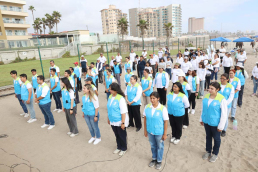On September 3, 2023, around 100 ASEZ university students gathered at Rosarito Beach in Baja California, Mexico, to conduct a Blue Carbon ecosystem cleanup and awareness campaign.


ASEZ members cleaned a 1 km [0.6 miles] section of Rosarito Beach, collecting over 800 kg [1,760 lbs] of waste, including plastic bottles, cans, paper, cigarette butts, and more. In addition to the cleanup, the students introduced ASEZ’s ABC Movement and practical activities for the protection of marine ecosystems to beachgoers.
The ABC Movement, short for “ASEZ Blue Carbon,” is ASEZ’s initiative for marine ecosystem protection in response to climate change. Key activities of this Movement include marine ecosystem cleanups and Blue Carbon awareness raising campaigns. Carbon on Earth is broadly categorized as black carbon, green carbon, and blue carbon. Black carbon refers to carbon produced from incomplete combustion of fossil fuels like coal and oil. Green carbon represents carbon absorbed by terrestrial ecosystems such as tropical forests, while blue carbon refers to carbon absorbed by marine ecosystems. ASEZ is currently using the ABC Movement to encourage the reduction of marine waste and raise awareness about the importance of marine ecosystem conservation for carbon neutrality.

Although the areas of blue carbon ecosystems, such as salt marshes, mangrove forests, and seagrass meadows, is smaller than terrestrial ecosystems, they can absorb carbon dioxide up to 50 times faster. Blue carbon ecosystems are gaining attention as a new greenhouse gas reduction method that can store carbon underwater for thousands of years, contributing to the fight against global warming. While the Korean government is promoting a Blue Carbon project using sea forests and tidal flats for carbon neutrality by 2050, Mexico has not yet presented a specific roadmap or declaration for carbon neutrality.
Therefore, the ABC Movement in Tijuana, Mexico, was particularly significant. Local residents of Tijuana joined the event, contributing to the conservation of marine ecosystems in the region, and the awareness campaign enhanced local residents’ understanding of Blue Carbon.

An ASEZ member from CETYS University said, “During my initial beach cleanup, I was taken aback by the amount of marine litter, surpassing my expectations. This showed how seriously the marine ecosystems were threatened. Picking up each piece of trash felt meaningful as it contributes to saving marine life. I also shared information about the Blue Carbon Movement with vacationers, informing them of how to protect the marine environment. I want to actively participate in such activities in the future.”
Another ASEZ member from UABC University said, “Through today’s event, I was reminded of the importance of the Blue Carbon Movement. As a biology major, I am deeply interested in research and technological development related to the marine environment. I will make efforts to protect marine ecosystems for sustainable development through ASEZ’s activities.”

Juan Jose from the Playas de Rosarito Municipality, said, “I am deeply impressed by the volunteer activities led by ASEZ university students. Let’s continue to work together to pass on a beautiful and clean marine ecosystem to future generations through such activities.”
Felipe Figueroa from the Mexican Coast Guard in Mexico said, “I have a keen interest in the Blue Carbon Movement led by ASEZ university students, and I will make more efforts to promote the Blue Carbon Movement in the future.”
ASEZ’s Blue Carbon Movement, which educates on how the ocean breathes and protects marine life, is expected to make a significant contribution to the global carbon neutrality goal. It is hoped that the efforts of ASEZ members in Mexico will be the beginning of many Mexicans loving and participating in the preservation of the sea.
RELATED POSTS
[Global Issue] Great Green Wall
2024-09-27
[Global Issue] RED LIST
2024-08-30
[Global Issue] #GenerationRestoration
2024-07-30









